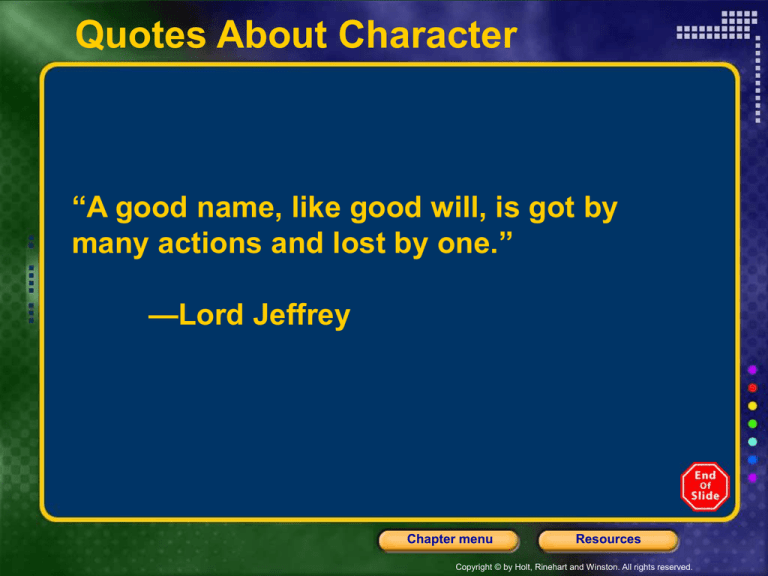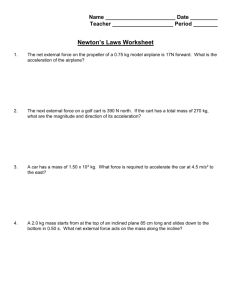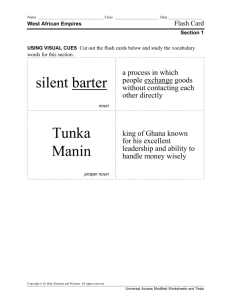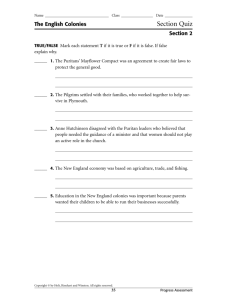
Quotes About Character
“A good name, like good will, is got by
many actions and lost by one.”
—Lord Jeffrey
Chapter menu
Resources
Copyright © by Holt, Rinehart and Winston. All rights reserved.
Chapter 10
Alcohol
Contents
• Section 1 Alcohol Affects the Body
• Section 2 Alcoholism Affects the Family and Society
• Section 3 Teens and Alcohol
Chapter menu
Resources
Copyright © by Holt, Rinehart and Winston. All rights reserved.
Chapter 10
Section 1 Alcohol Affects the Body
Objectives
• State why alcohol is considered a drug.
• List the short-term effects of alcohol use.
• Describe the long-term damage that alcohol does to
the organs of the body.
• Identify three reasons you should not drink alcohol.
Chapter menu
Resources
Copyright © by Holt, Rinehart and Winston. All rights reserved.
Chapter 10
Section 1 Alcohol Affects the Body
Alcohol Facts
• Teens drink alcohol to gain acceptance by peers.
• Alcohol is primarily the drug of choice for youths
ages 10-19 in PA.
• The average age in PA of first alcohol use is 13.
• There are an estimated 3.3 million teenage
alcoholics.
• Each year 2,200 teens are killed in car crashes
related to alcohol.
• BAC limit for 21- is .08%
Chapter menu
Resources
Copyright © by Holt, Rinehart and Winston. All rights reserved.
Chapter 10
Section 1 Alcohol Affects the Body
Alcohol Is a Drug
• Alcohol is the drug found in beer, wine, and liquor
that causes intoxication.
• Intoxication includes all the physical and mental
changes produced by drinking alcohol.
Chapter menu
Resources
Copyright © by Holt, Rinehart and Winston. All rights reserved.
Chapter 10
Section 1 Alcohol Affects the Body
Short-Term Effects of Alcohol
• Effects on the Body
1. Alcohol irritates the mouth, throat, esophagus, and
stomach.
2. Alcohol makes the heart work harder.
3. Alcohol makes the body lose heat.
4. Alcohol causes the liver to work harder.
5. Alcohol causes dehydration.
Chapter menu
Resources
Copyright © by Holt, Rinehart and Winston. All rights reserved.
Chapter 10
Section 1 Alcohol Affects the Body
Short-Term Effects of Alcohol
• Effects on the Mind
1.
2.
3.
4.
5.
Alcohol slows down the nervous system.
The drinker loses inhibitions. (decision making)
The drinker cannot focus his or her eyes.
The drinker may have slurred speech.
The drinker loses coordination, balance, and
judgment.
Chapter menu
Resources
Copyright © by Holt, Rinehart and Winston. All rights reserved.
Chapter 10
Section 1 Alcohol Affects the Body
Short-Term Effects of Alcohol
• Blood alcohol concentration (BAC) is the amount
of alcohol in a person’s blood expressed as a
percentage.
• Alcohol has different effects at different BACs.
• Binge drinking is the act of drinking five or more
drinks in one sitting.
• Binge drinking can lead to alcohol poisoning, and can
be fatal.
Chapter menu
Resources
Copyright © by Holt, Rinehart and Winston. All rights reserved.
Chapter 10
Section 1 Alcohol Affects the Body
Chapter menu
Resources
Copyright © by Holt, Rinehart and Winston. All rights reserved.
Chapter 10
Section 1 Alcohol Affects the Body
Long-Term Effects of Alcohol
• Prolonged use of alcohol can damage the heart,
blood, liver, kidneys, pancreas, the digestive tract,
and the immune system.
• Cirrhosis is a disease caused by long-term alcohol
use in which healthy liver tissue is replaced with scar
tissue.
Chapter menu
Resources
Copyright © by Holt, Rinehart and Winston. All rights reserved.
Chapter 10
Section 1 Alcohol Affects the Body
Long-Term Effects of Alcohol
• Alcohol causes permanent changes in the brain due
to cell death from dehydration and lack of oxygen.
• Alcoholism a leading cause of dementia in the United
States.
Chapter menu
Resources
Copyright © by Holt, Rinehart and Winston. All rights reserved.
Chapter 10
Section 1 Alcohol Affects the Body
Chapter menu
Resources
Copyright © by Holt, Rinehart and Winston. All rights reserved.
Essential Questions (#1-12)
1. How does alcohol dehydrate the body?
Alcohol and Dehydration Video
2. Why is alcohol considered a depressant drug?
Resource
3.
Why are females able to become intoxicated
more (increased BAC) than males?
Resource
Chapter menu
Resources
Copyright © by Holt, Rinehart and Winston. All rights reserved.
4.
Why is someone at a lighter weight than
someone able to become intoxicated more
(increased BAC) than someone heavier?
Resource
5. How is a Breathalyzer test able to measure
someone’s BAC?
How Breathalyzers Work Video
6.
If someone has a quantity of 4 shots at 2
ounces each all in a row, how much time will need
to pass before this person has a BAC that returns
to 0? Explain your reasoning.
Chapter menu
Resources
Copyright © by Holt, Rinehart and Winston. All rights reserved.
7. How is alcohol content able to get into one’s
bloodstream?
Alcohol Absorption Video
8. Explain using a short term effect of alcohol use
that could cause someone to injure themselves,
or someone else?
9. Describe the differences between a normal liver
and one with cirrhosis.
Cirrhosis Video
Chapter menu
Resources
Copyright © by Holt, Rinehart and Winston. All rights reserved.
10. Describe how alcohol effects the messages
being sent in the parts of the brain. Include
the terms (neurons, neurontransmitters,
dendrites, gaba, receptors, and chloride
ions).
Video 1
Video 2
Video 3
Chapter menu
Resources
Copyright © by Holt, Rinehart and Winston. All rights reserved.
11.
How does tolerance occur in the brain
after someone has used alcohol repeatedly?
Video
12.
Name the 5 parts of the brain and their
functions which are effected by alcohol use.
Video
Chapter menu
Resources
Copyright © by Holt, Rinehart and Winston. All rights reserved.
Chapter 10
Section 2 Alcoholism Affects the
Family and Society
Objectives
• State the difference between alcohol abuse and
alcoholism.
• Describe the stages in which alcoholism develops.
• Identify the warning signs of alcoholism.
• List three ways that alcohol use can have a negative
effect on family life.
• Describe how alcoholism affects society.
• Summarize two treatment options for overcoming
alcoholism.
Chapter menu
Resources
Copyright © by Holt, Rinehart and Winston. All rights reserved.
Chapter 10
Section 2 Alcoholism Affects the
Family and Society
What Is Alcoholism?
• Alcohol abuse is drinking too much alcohol, drinking
it too often, or drinking it at inappropriate times.
• Alcoholism is a disease that causes a person to
lose control of his or her drinking behavior.
• Alcoholics are physically and emotionally addicted to
alcohol, and suffer painful symptoms when they do
not have alcohol.
Chapter menu
Resources
Copyright © by Holt, Rinehart and Winston. All rights reserved.
Chapter 10
Section 2 Alcoholism Affects the
Family and Society
Alcoholism Develops in Stages
Chapter menu
Resources
Copyright © by Holt, Rinehart and Winston. All rights reserved.
Chapter 10
Section 2 Alcoholism Affects the
Family and Society
Alcoholism Develops in Stages
• Risk factors for alcoholism include:
• Age
• Social environment
• Genetics
• Risk-taking personality
Chapter menu
Resources
Copyright © by Holt, Rinehart and Winston. All rights reserved.
Chapter 10
Section 2 Alcoholism Affects the
Family and Society
Alcoholism Develops in Stages
Chapter menu
Resources
Copyright © by Holt, Rinehart and Winston. All rights reserved.
Chapter 10
Section 2 Alcoholism Affects the
Family and Society
There may be an alcohol problem if you:
•
•
•
•
•
Drink to calm nerves or forget worries.
Feel guilty about drinking.
Have unsuccessful attempts to quit drinking.
Lie or hide your drinking.
Cause harm to someone else as a result of your
drinking.
• Need to drinking an increased amount in order to
feel its effects.
• Have medical, family, or financial problems
because of the drinking.
Chapter menu
Resources
Copyright © by Holt, Rinehart and Winston. All rights reserved.
Chapter 10
Section 2 Alcoholism Affects the
Family and Society
Evaluate your relationships
1. Ask questions. Is this a healthy relationship?
2. Surround yourself with good people.
3. Get tough in a bad relationship. Stand up for
yourself.
4. Learn from your mistakes. (Everyone makes
them, just don’t make the same one twice!)
Chapter menu
Resources
Copyright © by Holt, Rinehart and Winston. All rights reserved.
Chapter 10
Section 2 Alcoholism Affects the
Family and Society
Alcoholism Affects the Family
• Families of alcoholics may suffer from the following:
•
•
•
•
•
•
Guilty feelings
Unpredictable behavior
Violence
Neglect and isolation
Protecting the alcoholic
Ignoring one’s own needs
Chapter menu
Resources
Copyright © by Holt, Rinehart and Winston. All rights reserved.
Chapter 10
Section 2 Alcoholism Affects the
Family and Society
Alcoholism Affects the Family
• Enabling means helping an addict avoid the
negative consequences of his or her behavior.
• Codependency is the condition in which a family
member or friend sacrifices his or her own needs to
meet the needs of an addict.
• Fetal alcohol syndrome (FAS) is a set of physical
and mental defects that affect a fetus that has been
exposed to alcohol because of the mother’s alcohol
consumption while pregnant.
Chapter menu
Resources
Copyright © by Holt, Rinehart and Winston. All rights reserved.
Chapter 10
Section 2 Alcoholism Affects the
Family and Society
Alcoholism Can Be Treated
• There are many treatment options for alcoholics.
• Alcoholics Anonymous (AA) is the most widely
used program. It involves a 12-step recovery method
and regular meetings.
• Al-Anon and Alateen provide treatment and support
for people with alcoholics in their family.
Chapter menu
Resources
Copyright © by Holt, Rinehart and Winston. All rights reserved.
Chapter 10
Section 3 Teens and Alcohol
Objectives
• Identify the role alcohol plays in teen driving
accidents.
• List the legal consequences of underage drinking.
• Summarize how underage drinking can harm a
teen’s future.
• List three ways you could refuse alcohol if it were
offered to you.
• Identify student groups and organizations that are
involved in educating people about the dangers of
alcohol.
Chapter menu
Resources
Copyright © by Holt, Rinehart and Winston. All rights reserved.
Chapter 10
Section 3 Teens and Alcohol
Drinking and Driving: The Facts
• In 1999, there were 14,709 alcohol related crashes.
• 34% of PA traffic deaths in 1999 were alcohol related.
• In 1999, 33% of driver’s 16-20 who were killed in
vehicle crashes had been drinking.
Chapter menu
Resources
Copyright © by Holt, Rinehart and Winston. All rights reserved.
Chapter 10
Section 3 Teens and Alcohol
Drinking and Driving: A Deadly Combination
• Motor vehicle accidents are the leading cause of
death among teens.
• Many of these accidents are alcohol-related.
(2,200 per year)
• Alcohol impairs driving through the following means:
•
•
•
•
•
Slows your reaction time
Affects your vision
Makes you drowsy
Reduces your coordination
Affects your judgment
Chapter menu
Resources
Copyright © by Holt, Rinehart and Winston. All rights reserved.
Chapter 10
Section 3 Teens and Alcohol
Drinking and Driving: A Deadly Combination
• Alcohol use is illegal for people under 21.
• Driving under the influence (DUI) applies to anyone
with a BAC above 0.08.
• The law has zero tolerance for anyone under 21
driving with .02 blood alcohol content.
Chapter menu
Resources
Copyright © by Holt, Rinehart and Winston. All rights reserved.
Chapter 10
Section 3 Teens and Alcohol
Drinking and Driving: A Deadly Combination
• To avoid getting in dangerous situations with an
intoxicated driver:
• Don’t drink
• Plan ahead: pick a designated driver
• Make arrangements with a parent for a ride
• Call a cab
• Walk as a group home.
Chapter menu
Resources
Copyright © by Holt, Rinehart and Winston. All rights reserved.
Chapter 10
Section 3 Teens and Alcohol
Drinking Puts Your Future at Risk
• Drinking and Jail You can be sent to jail for trying to
buy alcohol, possessing alcohol, possessing a fake
ID, or for drinking in a public place.
• Drinking and Sexual Activity The impaired
judgment from drinking can put you at risk of any of
the dangers of unplanned sexual activity.
Chapter menu
Resources
Copyright © by Holt, Rinehart and Winston. All rights reserved.
Chapter 10
Section 3 Teens and Alcohol
Drinking Puts Your Future at Risk
• Drinking and Diving Alcohol plays a role in more
than 38 percent of drowning accidents in the U.S.
• Drinking and Teen Brains Alcohol use affects the
rapidly developing brains of teens.
Chapter menu
Resources
Copyright © by Holt, Rinehart and Winston. All rights reserved.
Chapter 10
Section 3 Teens and Alcohol
Saying No to Alcohol
• Focus on Positive things in your life- Develop
talents or participate in athletics.
• Think Through the Situation- Think of the
consequences of your actions first!!
• Choose your friends carefully- Surround yourself
with “good” people who make “good” decisions.
*Remember anyone can act like a fool!!! It is
always harder to do the RIGHT thing!!
Chapter menu
Resources
Copyright © by Holt, Rinehart and Winston. All rights reserved.
Chapter 10
Section 3 Teens and Alcohol
Building Self Esteem
•A healthy self-esteem helps you resist pressure to do
things you know are unhealthy.
•The next slide reminds you of ways to build your selfesteem.
Chapter menu
Resources
Copyright © by Holt, Rinehart and Winston. All rights reserved.
Chapter 10
Section 3 Teens and Alcohol
Chapter menu
Resources
Copyright © by Holt, Rinehart and Winston. All rights reserved.
Chapter 10
Section 3 Teens and Alcohol
Chapter menu
Resources
Copyright © by Holt, Rinehart and Winston. All rights reserved.
Chapter 10
Section 3 Teens and Alcohol
Building Resiliency
• Being offered alcohol can be a stressful situation.
Resilient people continue to be optimistic when life
gets tough. The next slide provides eight skills to
help build your resiliency.
Chapter menu
Resources
Copyright © by Holt, Rinehart and Winston. All rights reserved.
Chapter 10
Section 3 Teens and Alcohol
Chapter menu
Resources
Copyright © by Holt, Rinehart and Winston. All rights reserved.
Chapter 10
Section 3 Teens and Alcohol
Joining the Fight Against Drunk Driving
• Two organizations that spread information and work
to end problems with drunk driving are:
• Mothers Against Drunk Driving (MADD)
• Students Against Drunk Driving (SADD)
Chapter menu
Resources
Copyright © by Holt, Rinehart and Winston. All rights reserved.
End of Chapter 10 Show
Chapter menu
Resources
Copyright © by Holt, Rinehart and Winston. All rights reserved.
Quotes About Character
“One falsehood spoils a thousand truths.”
—African Proverb
Chapter menu
Resources
Copyright © by Holt, Rinehart and Winston. All rights reserved.
Quotes About Character
“When the character of a man is not clear to
you, look at his friends.”
—Japanese Proverb
Chapter menu
Resources
Copyright © by Holt, Rinehart and Winston. All rights reserved.
Quotes About Character
“A good name, like good will, is got by
many actions and lost by one.”
—Lord Jeffrey
Chapter menu
Resources
Copyright © by Holt, Rinehart and Winston. All rights reserved.
Quotes About Character
“The reputation of a many years may be
determined by the conduct of one hour.”
—Japanese Proverb
Chapter menu
Resources
Copyright © by Holt, Rinehart and Winston. All rights reserved.
Quotes About Character
“Rather fail with honor than succeed by
fraud.”
—Sophocles
Chapter menu
Resources
Copyright © by Holt, Rinehart and Winston. All rights reserved.
Quotes About Character
“To know what is right and not do it is the
worst cowardice.”
—Confucius
Chapter menu
Resources
Copyright © by Holt, Rinehart and Winston. All rights reserved.
Quotes About Character
“It takes less time to do a thing right, than it
does to explain why you did it wrong.”
—Henry Wadsworth Longfellow
Chapter menu
Resources
Copyright © by Holt, Rinehart and Winston. All rights reserved.
Quotes About Character
“You can easily judge the character of a
man by how he treats those who can do
nothing for him.”
—James D. Miles
Chapter menu
Resources
Copyright © by Holt, Rinehart and Winston. All rights reserved.
Quotes About Character
“Right is right, even if everyone is against
it; and wrong is wrong, even if everyone is
for it.”
—William Penn
Chapter menu
Resources
Copyright © by Holt, Rinehart and Winston. All rights reserved.
Quotes About Character
“Character is much easier kept than
recovered.”
—Thomas Paine
Chapter menu
Resources
Copyright © by Holt, Rinehart and Winston. All rights reserved.
Quotes About Character
“Character is a by-product; it is produced in
the great manufacture of daily duty.”
—Woodrow T. Wilson
Chapter menu
Resources
Copyright © by Holt, Rinehart and Winston. All rights reserved.









